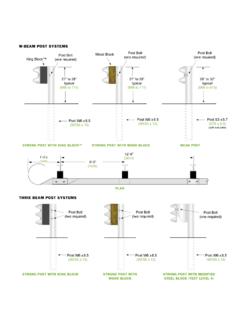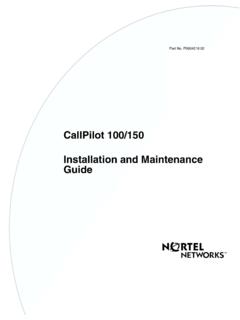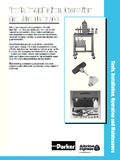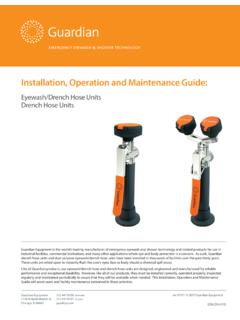Transcription of The following is an installation guide to assist ...
1 Revised March 2007. TRINITY. HIGHWAY PRODUCTS. 1. The following is an installation guide to assist contractors, filed inspectors and maintenance personnel to insure proper installation and maintenance of WY-BET. End Terminals. The installer and/or inspector should be familiar with the standard plans and the project plans and use them together with this guide to insure proper installation . This document does not waive nor does it override the specifications. All dimensions in this document are in millimeters unless otherwise shown. For convenience, English dimensions have been shown in parenthesis. INTRODUCTION. A successful installation of guardrail requires carefully adhering to the details shown in the plans combined with the correct grading of the terrain, proper alignment and correct mounting height. End terminals such as the WY-BET. require special attention because the details are a little more complicated, and generally more significant if deviated from. There are two major types of WY-BET End Terminals.
2 The shoulder barrier WY- BET and the median barrier WY-BET (MB). The major difference being that the post are mounted underneath for the median barrier version so that it can be impacted from either side, as opposed to the behind the rail post mounting for the WY-BET shoulder barrier version. The WY-BET median barrier also has a wood strut mounted on the wood end post; a bottom plate welded to the foundation tube which holds the wood post thus requiring the foundation tube to be drilled rather that driven into the ground; a connection sleeve that adapts the 152 x 152. (6 x6 ) inner rail to the 203 x 152 (8 x6 ) standard median barrier rail; and the necessary modification from paddle mounted median barrier to a bolted positive connection for a minimum of the next 10 posts downstream of the end terminal. Figure 1 A completed WY-BET (MB) - median installation . The relatively flat grading around guardrail and end terminal helps to insure that errant vehicles will strike the terminal at the right height.
3 2. The WY-BET is designed so that the outer rail telescopes over the inner rail during end-on impacts, crushing the fiberglass/epoxy composite tubes inside the outer rail, absorbing the energy of the vehicle's momentum and bringing it to a controlled stop. During the process, the wood post breaks away at the base, releasing the cable anchorage allowing the terminal to telescope. Figure 2 For end on impacts, the wood end post breaks at the base, releasing the cable anchorage, and begins to telescope. The composite tubes inside the outer rail crush and bring the vehicle to a controlled stop. For side impacts, the WY-BET functions like a standard run of box-beam guardrail. The wood post remains intact, providing the tensile anchorage at the beginning of the terminal. The tensile connector downstream of the nose holds the outer rail together with the inner rail thereby maintaining tension in the rail. The rail redirects a vehicle by tensile force developed in the rail, somewhat like pushing on the middle of a rubber band which is supported at its ends.
4 Posts maintain the rail at the proper mounting height, provide some lateral support to limit the deflection of the rail, yet bend to allow the vehicle to pass over the posts without snagging the vehicle. Corrugated Beam Guardrail differs in that it uses larger, stronger posts which reduce the guardrail deflection more than box beam, but would snag a vehicles wheels if it weren't for the block-outs mounted to the post thereby separating the rail and hence the vehicle's wheels from snagging on those strong posts. Figure 3 For side impacts, WY-BET performs like box-beam guardrail. 3. GRADING. Proper site grading is very important for all guardrail installations. The ground cross-slope from the roadway shoulder to the face of any guardrail should be 1:8. (rise to run) or flatter. This slope should extend a minimum of m (2 ft.) behind the guardrail. For projects which accommodate grading operations, this minimum distance behind the guardrail should extend to m (4 ft.) behind the guardrail at the nose of the terminal when possible.
5 It is strongly recommended to smoothly flatten the slope to a 1:10 or flatter at the nose of the terminal. A. traversable cross-slope, 1:3 or flatter (preferably 1:4 or flatter) should be provided behind the guardrail (starting at the slope break line) for all installations in which the guardrail terminates inside the clear zone. Relatively flat grading at guardrail and end terminals helps to prevent errant vehicles from striking these appurtenances either too high or too low. Figure 4A- Cross slope into the face of guardrail should be 1:8 (rise to run). or flatter. That slope should be flattened to a 10:1 or flatter at the nose of the terminal. Figure 4B- Preferred minimum slope treatment around the end terminal where grading operations permit this treatment. The alignment should be set as shown in the project plans as established by the appropriate design methodology (which is beyond the scope of this guide ). Some WY-BET Terminals are specified to be tangent to the roadway while others are flared away from the roadway.
6 If the WY-BET is flared, it should not be flared at a rate steeper that 1:15 with respect to the roadway. It is advised to slightly flare the terminal from the roadway, even on tangent installations if the slope grading requirements can still be met. This reduces the likelihood of a nuisance 4. impact, such as a snowplow clearing snow from the shoulder of the road. It is desirable to have the nose of the terminal set behind the line delineators when possible. Whether flared or not flared, the entire length of the WY-BET must be installed straight and true to allow it to properly telescope when needed. PRIOR TO installation . The following must be performed on each WY-BET prior to installation . Place the outer rail on the back of a flat bed or other suitable location. Slide the inner rail inside the outer rail for its full length using manual labor only. The labor should only need to overcome the weight of the inner rail. The inner rail shall slide smoothly and freely with no binding whatsoever.
7 If any binding does occur, the rails shall be marked for rejection and returned to the fabricator immediately. In addition to the previous requirements, no tube shall have any camber that exceeds 25 mm (1 ). Figure 5 Sliding inner rail inside outer rail to insure rails will telescope freely. POST installation . Posts should be installed at the proper spacing, alignment, and mounting height. Care should be taken since there is some variation in spacing for certain posts in the median barrier WY-BET (MB). Also, the rail gap is different at the junction of the median barrier WY-BET (MB) to facilitate the connection sleeve that adapts the 152 x 152 (6 x6 ) inner rail to the 203 x 152 (8 x6 ) standard median barrier rail. 5. Post Modification for Paddle Mounted Post 9 thru 18 for WY-BET (MB) Only: For box beam median barrier that is mounted on the old paddle configuration, a minimum of the first 10 posts downstream of the terminal shall be modified to a positive bolted connection. It is recommended to modify additional paddle mounted posts, but only 10 posts are required for the WY-BET (MB) installation .
8 Figure 6 Positive (bolted) Connection Post mounting for at least the next 10. posts downstream of the end terminal (posts 9 thru 18). Posts 2, 3, 4 have slide brackets to allow the outer rail to telescope. Figure 7 WY-BET posts 2, 3, 4 WY-BET (MB) posts 2, 3, 4. Post 5 is not bolted to the rail. The WY-BET (MB) has a support bracket attached to the post only, the WY-BET (shoulder barrier version) has no bracket. It is permissible to slightly alter the post space for post 5 so it does not interfere with the tensile connector. Figure 8 WY-BET post 5 WY-BET (MB) post 5- notice support bracket angles away from nose. Posts 6, 7, 8 require special hardware since the WY-BET's outer rail will telescope over the inner rail and shear each connection. Note that the shear 6. connection support bracket is different than the standard support bracket. The MB (5/16 ) Shear Bolt is smaller than the standard M10 (1/2 or 7/16 ) bolt. A. reflective channel is required rather than the standard guardrail reflective washer to prevent it from wedging inside the telescoping outer tube.
9 It is very important to orient the median barrier support bracket so it angles away from the nose of the terminal (also to prevent wedging). Notice this bracket also has a slight turn down to it. Figure 9 WY-BET posts 6, 7, 8 WY-BET (MB) posts 6, 7, 8-notice support bracket angles away from nose. FOUNDATION TUBE, GROUND STRUT, AND POST #1. installation . It is very important that the foundation tube for post #1 is placed exactly as required. If not, it could affect the overlap of the outer rail on both ends and could require resetting of the foundation tube if the specified overlap is not achieved. Assuming the components are fabricated to specifications, the dimension from the end of the inner tube to the centerline of post 1 as shown on the cover of this guide can be used to locate the proper placement of the foundation tube. The foundation tube (w/soil bearing plate attached) for post #1. should be placed in the ground at the proper location followed by the second foundation tube (w/soil bearing plate attached) unless the alternate concrete foundation is used.
10 The foundation tube for the median barrier WY-BET (MB). has a soil plate welded to the bottom of the first foundation tube. This configuration cannot be driven into the ground, therefore it is therefore necessary to drill a hole and then thoroughly compact the backfill in 6 inch lifts. The foundation tubes typically extend roughly 50 mm (2 ) above ground. In no case shall the tubes be greater than 100 mm (4 ) above ground (otherwise the grading and/or mounting height is not correct). If the ground strut is too high, it could potentially snag a vehicle's undercarriage if the terminal is impacted. The ground strut is placed between the two foundation tubes (unless the alternate single concrete foundation is used). The wood post is inserted into the foundation tube and the bolt inserted through the ground strut, foundation tube and wood post. A bolt is also placed through the ground strut and the second foundation tube. Note the median barrier WY-BET (MB) also has a wood strut attached to the wood post.









